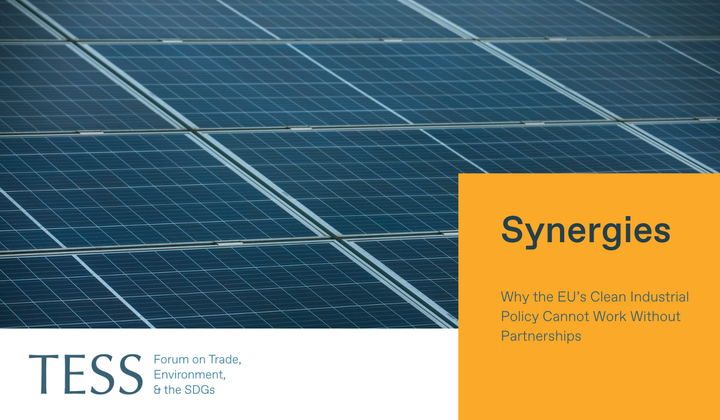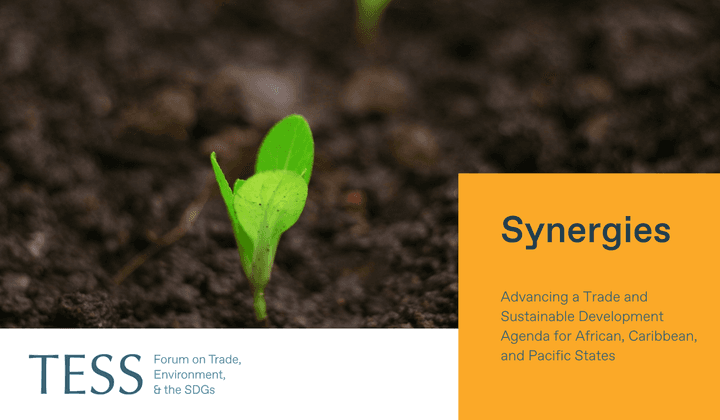The ability of developing countries to navigate the European Union’s evolving green trade architecture will depend on whether they can turn externally imposed rules into domestic opportunities. Strategic engagement, regional coherence, and sustained investment in local capabilities can make the difference between treating these measures as restrictive barriers, or using them as catalysts for industrialization and long-term market opportunities.
This article is part of a Synergies series on climate and trade curated by TESS titled Addressing the Climate Crisis and Supporting Climate-Resilient Development: Where Can the Trading System Contribute? Any views and opinions expressed are those of the author(s) and do not necessarily reflect those of TESS or any of its partner organizations or funders.
-----

The European Union’s trade policy is evolving, from an “old” trade and development agenda—built around negotiated agreements and preferential market access—towards a “new” more unilateral approach to trade and investment in key goods, increasingly shaped by sustainability-related measures.
From the Carbon Border Adjustment Mechanism (CBAM) and the EU Deforestation Regulation (EUDR) to corporate sustainability due diligence rules (CS3D/CSRD), or new product standards through the eco-design for sustainable products regulation (ESPR), the EU increasingly extends the application of its internal sustainability requirements to imported goods.
For many developing countries, these new and upcoming measures are often seen as burdensome and intrusive, and not without reason. They tend to come with high compliance costs, limited consultation, and little room for dialogue. Additional expenses associated with such measures include hiring verification services to meet reporting requirements under CS3D, providing facility-level emissions data under CBAM (often unavailable at firm-level), or facing the indirect costs of losing contracts to suppliers that can more easily comply. In all but a few cases, the complexity and cost of accessing the EU market will increase.
Why a Proactive Approach Matters
There are compelling reasons for developing countries to engage proactively in the implementation of new sustainability-related trade measures.
Yet, pragmatically, there are compelling reasons for developing countries to engage proactively, both individually and collectively, to adapt to and shape the implementation of new sustainability-related trade measures.
These measures are a signpost for market direction. The EU is the first major economy to make sustainability—and even embedded emissions—a condition for market access, but others are following. The UK will introduce a CBAM in 2027, and major economies such as Japan, Canada, and China are exploring similar border adjustment mechanisms. Early compliance with product standards—from traceability under the EUDR to circular-design requirements under the ESPR—can help safeguard long-term market access, even if for many developing countries this means continually adapting to evolving external requirements; a moving target that can strain capacities and competitiveness.
Furthermore, while there has been some political “green backtracking” in Europe, the overall trajectory remains steady. Implementation delays for the EUDR or simplifications of the CS3D so far have been technical adjustments, not reversals, often driven by European private sector concerns; not those in third countries. The EU’s commitment to using trade as a lever for its green transition remains largely unchanged.
Turning Compliance Into Competitiveness
Even if “going green” will likely be costly and cumbersome, in some cases EU green trade measures may create new opportunities. Producers that can move faster to decarbonize, attract new investments in green industries and hydrogen economies, or otherwise take advantage of new product standards and reporting requirements, may be able to lock in market access early, or position themselves for longer term export opportunities, provided investments and clear demand signals are there.
Some developing countries and sectors are already finding ways to use new rules to strengthen competitiveness and attract investment.
Some developing countries and sectors are already finding ways to use new rules to strengthen competitiveness and attract investment. For example, Ghana and Côte d’Ivoire have introduced traceability systems in their cocoa sectors that, if compatible with EU requirements, could give them a solid basis for EUDR compliance.
While we often focus on the short-term, direct impacts of CBAM on existing exports, for some, the potential opportunity for new energy-intensive industries in the medium to long term may be far greater than the short-term costs. The Middle East and North Africa region, for example, has the potential to become a highly competitive exporter of green iron, due to its unique renewable energy potential and existing industrial base.
Other countries, like Mozambique, could leverage their hydropower potential to decarbonize existing aluminium production, improving its market position under CBAM considerably once indirect emissions are included. Egypt Aluminium also recently moved ahead with a 25-year Power Purchasing Agreement with a 1.1 GW solar and collocated battery storage project developed by Norway’s Scatec, making it one of the region’s first major decarbonization projects that is directly linked to CBAM.
Beyond Reactive Compliance
While early movers may be able to lock in markets and signal investment readiness, there are limits to what a reactive approach can achieve. Meeting EU standards is not the same as shaping global ones. Imposed rules alone are unlikely—as the EU hopes—to create sufficient incentives for technological change like decarbonization or for significantly altering corporate behaviour, let alone promoting economic transformation. Developing countries will increasingly need to define their own pathways for green trade and industrial transformation.
Developing countries will increasingly need to define their own pathways for green trade and industrial transformation.
Examples from the agricultural sector include palm oil certification in Indonesia and Malaysia and the trustea code in India. A key challenge is to ensure these homegrown standards and practices—which arguably better reflect local conditions—are recognized internationally. This signals a need for stronger cooperation on equivalence and mutual recognition between the EU and partner countries.
In other sectors, European measures may go far beyond what exists locally. Few developing countries, for example, have carbon pricing mechanisms in place, let alone the capabilities to monitor industrial emissions, which may increase their compliance burden or lead to higher costs by relying on default emissions values.
At a minimum, countries should strive to localize ESG services as much as possible. Building domestic ecosystems for emissions monitoring, traceability, and due diligence services can reduce dependence on costly foreign intermediaries, creating a pool of strategic skills and capabilities that countries will require for the foreseeable future. Doing so will also strengthen their negotiating position towards the EU on timelines and implementation measures, as well as increase their investment readiness for other markets.
Regional alignment could take this to the next level. Regional institutions and initiatives like the African Continental Free Trade Area (AfCFTA) could provide a platform for harmonizing green trade standards, share the cost of traceability systems, and also potentially emissions monitoring systems, and strengthen regional value chains and collective bargaining power vis-à-vis external partners.
It is of great importance that developing countries take ownership of the green trade agenda and move the discussion away from the unilateral space.
Yet, of even greater importance is for developing countries to take ownership of the green trade agenda and move the discussion away from the unilateral space. EU unilateral measures are shaped by internal market dynamics, like the Emissions Trading System (ETS) reform for CBAM or corporate reporting rules for CS3D. They are not designed with partner realities in mind. In this context, multilateral initiatives such as the COP30 presidency proposal for a global integration of carbon markets are essential to start reshaping green trade as a global concern, driven both by developing countries and industrialized markets such as the EU.
All of these efforts can help build a stronger case for climate-compliance finance. The complexity and costs of “going green” are undeniable, and, in many cases, there is no clear test case for mutual benefits under green trade regimes. The EU and its partners should scale up dedicated support, be it through dedicated Clean Trade and Investment Partnerships or a new "aid-for-green-trade" approach under its Global Gateway investment programme.
An Uneven Playing Field
The decarbonization of the EU and other markets, and the proliferation of green trade measures, will lead to a reconfiguration of global economic opportunities. Some developing countries will be able to leverage their renewable energy potential, industrial capabilities, or existing regulatory frameworks better than others.
It also bears repeating that the playing field is uneven from the start. Developing countries are asked to comply while the EU changes the rules with only limited regard to their concerns and capacity to absorb the costs of an accelerated sustainability transition.
Yet regardless of the fairness question, the ability of developing countries to navigate the EU’s evolving green trade architecture will depend on whether they can turn externally imposed rules into domestic opportunities. Strategic engagement, regional coherence, and sustained investment in local capabilities can make the difference between treating these measures as restrictive barriers, or using them as catalysts for industrialization and long-term market opportunities.
----------
Alfonso Medinilla is the head of ECDPM's climate action and green transition team. He focuses on the geopolitics of the global green transition and renewable energy.
-----
Synergies by TESS is a blog dedicated to promoting inclusive policy dialogue at the intersection of trade, environment, and sustainable development, drawing on perspectives from a range of experts from around the globe. The editor is Fabrice Lehmann.
Disclaimer
Any views and opinions expressed on Synergies are those of the author(s) and do not necessarily reflect those of TESS or any of its partner organizations or funders.
License
All of the content on Synergies is licensed under a Creative Commons Attribution-NonCommercial-ShareAlike 4.0 International (CC BY-NC-SA 4.0) license. This means you are welcome to adapt, copy, and share it on your platforms with attribution to the source and author(s), but not for commercial purposes. You must also share it under the same CC BY-NC-SA 4.0 license.
If you would like to reuse any material published here or if you have any other question related to Synergies, send an email to fabrice.lehmann@graduateinstitute.ch.




